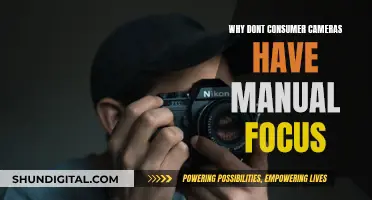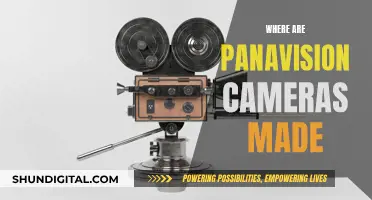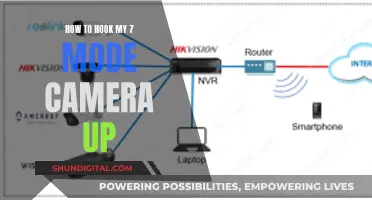Video surveillance cameras are everywhere, and their potential for misuse is a concern for many. While it's impossible to avoid them entirely, there are ways to minimise the risk of being identified. One method is to wear a hooded sweatshirt or coat with your face buried in the hood, as most cameras are mounted several feet overhead. Another option is to use infrared LED lights or a laser pointer aimed directly at the lens of a camera, which obscures the image without causing any damage. Additionally, some artists and startups have created clothing and accessories that use patterns and fabrics to trick surveillance systems. For example, a scarf designed to be worn like a hijab can disguise the wearer from overhead drones, and t-shirts with adversarial printed images can help mask people from people-detecting surveillance.
| Characteristics | Values |
|---|---|
| Wearable items | Paper masks, hooded sweatshirts, scarves, hijabs, t-shirts, hoodies |
| Makeup | Asymmetry, tonal inverse, covering nose bridge |
| Accessories | Laser pointers, infrared LED lights |
What You'll Learn

Wear a paper mask
Wearing a paper mask is one way to avoid facial recognition technology. This method has been tested by artificial intelligence startup company Kneron, based in San Diego, California. Researchers at Kneron were able to trick facial recognition systems across three continents by wearing paper masks. The researchers even fooled systems at a border crossing point in China and at Amsterdam's Schipol Airport.
The URME Surveillance company also offers a paper mask with a photo-realistic, 3D-printed prosthetic "face" resembling founder Leo Savaggio. When people wear this mask, facial recognition software identifies them as Savaggio, hiding their true identity. URME offers free instructions and a kit for its paper mask online.
However, it is important to note that attempting to trick airport facial recognition technology may result in arrest.
The First Camera Phone: A Revolutionary Invention
You may want to see also

Use infrared LED lights to obscure the camera image
Infrared LEDs can be used to obscure your identity from surveillance cameras. The human eye can see up to around 740nm, so using infrared LEDs with a wavelength of 850nm or higher will make the lights invisible to the naked eye.
To obscure your identity, you can attach infrared LEDs to your clothing or embed them into your clothes. The lights will need to be bright enough to blot out your face from the camera's view. Be careful not to blind yourself with the infrared LEDs.
When using infrared LEDs to obscure your identity, it's important to consider the viewing angle of the LEDs. If you turn your head slightly, the LEDs may no longer be effective in obscuring your face. Additionally, the brightness of the LEDs may not be sufficient to obscure your face from a camera that is far away.
It's also worth noting that while infrared LEDs can obscure your identity, they will not hide your presence. A person watching through the camera will still be able to tell that someone is there, but they won't be able to see your face clearly.
Softening Skin Tones in Camera Raw: A Guide
You may want to see also

Wear a hooded sweatshirt
Wearing a hooded sweatshirt can be an effective way to avoid detection by surveillance cameras, especially those that use facial recognition technology. While it may not be a foolproof method, it can increase your chances of remaining anonymous in several ways.
Firstly, a hooded sweatshirt can provide a level of physical concealment. By pulling the hood over your head, you can partially obscure your facial features from the view of cameras. This is a simple yet effective tactic that can reduce the amount of your face that is visible to the camera.
Additionally, the choice of clothing pattern can play a crucial role in avoiding detection. Researchers from Facebook and the University of Maryland have created sweatshirts that exploit a quirk in computer vision algorithms. These algorithms use a simple approach to identifying objects by looking for specific patterns of pixels. The sweatshirts designed by the researchers confuse these algorithms by overwhelming them with false patterns, making it challenging for them to identify a human face.
Another strategy is to incorporate reflective or shiny materials into your hooded sweatshirt. This can help to deflect or distort the image captured by the camera, making it more difficult for the algorithm to accurately identify human features. This approach is similar to the concept of using infrared-blocking sunglasses to prevent infrared cameras from capturing your facial features.
It is worth noting that while wearing a hooded sweatshirt can enhance your privacy, it may not always be a guarantee of anonymity. As surveillance technology advances, it is important to stay informed about the latest tactics to protect your identity. Combining multiple strategies, such as those mentioned above, can increase your chances of remaining undetected by surveillance cameras.
Dispute Camera Tickets in Lake Forest Park, WA: What You Need to Know
You may want to see also

Use a laser pointer to aim at the camera lens
Using a Laser Pointer to Disrupt a Surveillance Camera
A laser pointer can be used to disrupt the functionality of a surveillance camera by aiming it directly at the lens. The lens is a sensitive part of the camera, responsible for collecting light and converting it into digital data to form an image. When a laser is shone onto the lens, it can overwhelm the lens with light, disrupting the image. This disruption can cause temporary blindness or even permanent damage to the lens, resulting in dead pixels, dark spots, or lines in the generated image.
The damage caused by a laser pointer depends on two main factors: the distance from which the laser is pointed at the camera, and the duration of exposure. Lasers with power as low as 5 milliwatts can damage a camera if pointed at it for a long time. As the laser power increases beyond 5 milliwatts, the potential for damage also increases, and the exposure time needed to cause harm decreases.
It is important to note that pointing a laser at a camera lens can be illegal in some places, as it may be considered vandalism or interference with surveillance. Additionally, it is crucial to prioritize eye safety and never look directly into a laser pointer or view it through a camera's viewfinder.
To protect surveillance cameras from laser pointers, strategic placement, such as installing cameras at hidden angles or heights, or behind protective barriers, can make it more difficult for individuals to target the lenses. Additionally, protective shields and anti-laser technology, such as covers that diffuse or block laser beams, can be effective in preventing laser damage.
Unleashing Adobe Camera Raw: A Beginner's Guide
You may want to see also

Wear anti-surveillance hijabs
Hijab-wearing women are often the targets of surveillance cameras, particularly in countries like Iran, where the hijab is compulsory in public, and France, where there is a long history of hijabophobia. To avoid being tracked by surveillance cameras, hijab-wearing women can consider wearing anti-surveillance hijabs.
Artist Adam Harvey has been working on counter-surveillance fashion, which he calls Stealth Wear, since 2009. One of his concepts, now sold out, is a scarf that can be worn like a hijab to disguise oneself from overhead drones. Harvey's garments are made with silver-plated fabrics that can reflect thermal radiation. He believes that by 2050, countries will be able to perform full surveillance on their populations for just 0.01% of GDP.
While Harvey's anti-surveillance hijab may be sold out, there are likely other similar options on the market. When shopping for an anti-surveillance hijab, look for something made with reflective material, like silver-plated fabrics, to help disguise your body's thermal radiation. Additionally, consider the weight and thickness of the fabric. A heavier, thicker fabric may provide more coverage and make it harder for surveillance cameras to detect your body's contours.
It's also important to be aware of the limitations of anti-surveillance hijabs. While they may help disguise you from overhead drones, they may not be effective against all types of surveillance cameras. For example, facial recognition technology is becoming increasingly advanced and may still be able to identify you even while wearing an anti-surveillance hijab. Additionally, always be mindful of local laws and regulations regarding the use of such technology, as well as your own personal safety.
Customizing Your FO76 Camera: A Step-by-Step Mod Guide
You may want to see also
Frequently asked questions
There are a few ways to avoid being tracked by surveillance cameras. One way is to wear a hooded sweatshirt or coat with your face buried deep inside the hood. Another way is to use a laser pointer or infrared LED lights to aim directly at the lens of a camera, obscuring the image without causing any damage to the camera.
Some ways to trick surveillance cameras include wearing a paper mask, using anti-surveillance hijabs, or creating an "anti-face" with quirky hairstyles and makeup that breaks up the continuity of a face.
One way to avoid being tracked by license plate readers is to purchase clothing with license plates printed on them, which can confuse the system by injecting junk data.







